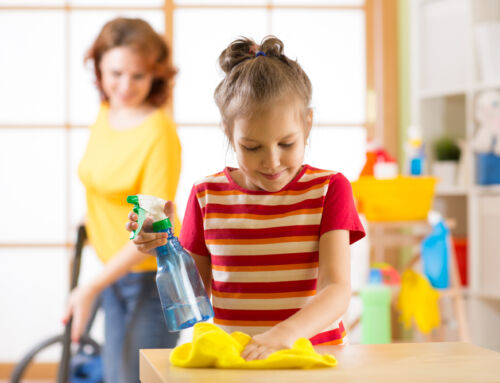Having pets brings immense joy and companionship to our lives, but it’s no secret that they can leave behind messes and odors. As a pet owner, maintaining cleanliness in your home becomes crucial not only for a pleasant living environment but also for the health and well-being of both you and your furry companions. In this article, we will explore effective cleaning strategies and product recommendations to help you tackle pet-related messes and ensure a hygienic and odor-free home environment.
Introduction
Living with pets comes with its fair share of challenges, but with the right approach, you can maintain a clean and fresh home. By following some simple cleaning routines and utilizing pet-friendly cleaning techniques, you can keep your living space tidy and enjoyable for everyone.
Creating a Cleaning Routine
Establishing a cleaning routine is essential when you have pets. Regular cleaning habits will help you stay on top of any messes and prevent them from becoming overwhelming.
Daily maintenance tasks
Start by incorporating daily maintenance tasks into your routine. This includes simple actions like sweeping or vacuuming the floors to remove pet hair, wiping down surfaces, and picking up any scattered toys or items. These small efforts go a long way in maintaining cleanliness throughout your home.
Weekly deep cleaning tasks
In addition to daily maintenance, set aside time for weekly deep cleaning tasks. This includes more thorough cleaning of floors, furniture, and other surfaces. It’s also an opportunity to check and clean your pet’s bedding and toys.
Cleaning Tips for Pet-Related Messes
Pets can create messes that require specific cleaning techniques. Here are some tips to help you tackle common pet-related messes effectively:
Dealing with pet hair
Pet hair can seem never-ending, but there are ways to manage it. Regularly brushing your pet’s coat not only reduces shedding but also helps keep their hair off your furniture and floors. Use a pet-specific vacuum or a vacuum with specialized pet hair attachments to effectively remove pet hair from carpets, upholstery, and other surfaces.
Removing pet stains and odors
Accidents happen, but it’s important to address them promptly. For pet stains on carpets or upholstery, blot the area with a clean cloth and use an enzymatic cleaner specifically designed for pet stains. These cleaners break down the proteins in urine, eliminating the odor and preventing your pet from remarking the same spot.
Cleaning pet bedding and toys
Pet bedding and toys can harbor dirt, dander, and unpleasant smells. Wash your pet’s bedding regularly using pet-safe laundry detergent, and don’t forget to clean their toys too. Check the care instructions for specific cleaning recommendations.
Choosing Pet-Friendly Cleaning Products
When selecting cleaning products for your home, it’s crucial to choose ones that are safe for your pets. Avoid using products that contain harmful chemicals, as pets can come into contact with these substances through licking or walking on freshly cleaned surfaces.
Avoiding harmful chemicals
Many common household cleaning products contain ingredients that can be toxic to pets. Ingredients such as bleach, ammonia, and certain essential oils can be harmful when ingested or inhaled by animals. Read product labels carefully and opt for pet-friendly alternatives.
Natural and eco-friendly alternatives
Fortunately, there are numerous natural and eco-friendly cleaning products available that are safe for both your pets and the environment. Look for products that are labeled as non-toxic, biodegradable, and made with natural ingredients. Vinegar, baking soda, and lemon juice are also excellent natural cleaning agents that can be used effectively.
Pet-Friendly Cleaning Techniques for Different Surfaces
Different surfaces require specific cleaning techniques to ensure effective cleaning while keeping them in good condition. Here are some pet-friendly cleaning techniques for common surfaces in your home:
Hardwood floors
When cleaning hardwood floors, avoid excessive moisture as it can damage the wood. Instead, use a microfiber mop or a soft broom to remove dirt and pet hair. For deeper cleaning, use a hardwood floor cleaner recommended for pet owners.
Carpets and rugs
Regular vacuuming is key to keeping carpets and rugs clean when you have pets. Invest in a vacuum cleaner with strong suction and a brush roll designed to pick up pet hair. Consider steam cleaning your carpets periodically to remove deeply embedded dirt and eliminate odors.
Upholstery and furniture
Pet hair and stains can be particularly challenging to remove from upholstery and furniture. Use a lint roller or a damp rubber glove to remove pet hair from fabric surfaces. For stains, refer to the manufacturer’s instructions for cleaning recommendations, or consider professional upholstery cleaning services.
Walls and baseboards
Walls and baseboards can accumulate dirt and pet markings over time. Regularly wipe them down using a mild detergent or a pet-safe cleaner. Avoid using abrasive materials that can damage the paint or finish.
Preventing Future Messes
While cleaning up messes is necessary, preventing them in the first place is even better. Here are some strategies to help you minimize future messes caused by your pets:
Training and behavior management
Properly training your pets and managing their behavior can significantly reduce accidents and messes. Invest time in training them to follow commands, use designated potty areas, and respect boundaries within your home.
Using protective covers and barriers
Consider using protective covers on furniture and other surfaces where your pets frequently rest or play. This will help prevent stains and damage. You can also use baby gates or pet gates to restrict access to certain areas of your home.
Maintaining Air Quality
Maintaining good air quality is crucial when living with pets, as they can contribute to allergens and pet dander in the air. Here are some tips to improve air quality in your home:
Controlling pet dander and allergens
Regularly groom your pets to reduce the amount of loose hair and dander they shed. Vacuum and dust your home regularly to remove pet dander from surfaces. Consider using a HEPA filter in your vacuum cleaner to effectively trap pet allergens.
Ventilation and air purification
Ensure proper ventilation in your home by opening windows or using exhaust fans to allow fresh air to circulate. Additionally, using air purifiers with HEPA filters can help remove airborne pet dander and other allergens, improving the overall air quality in your home.
Conclusion
Living with pets doesn’t mean sacrificing a clean and fresh home. By establishing a cleaning routine, utilizing pet-friendly cleaning techniques, and choosing the right products, you can maintain a hygienic and odor-free environment. Remember to prevent future messes through training and behavior management, and prioritize air quality by controlling pet dander and ensuring proper ventilation. With these strategies in place, you can enjoy a clean home while cherishing the companionship of your beloved pets.
FAQs
- How often should I clean my pet’s bedding? It’s best to wash your pet’s bedding at least once a week to remove dirt, dander, and odors. However, if your pet has specific allergies or skin conditions, you may need to wash it more frequently.
- What should I do if my pet has an accident on the carpet? If your pet has an accident on the carpet, quickly blot the area with a clean cloth to absorb as much liquid as possible. Then, use an enzymatic cleaner specifically designed for pet stains to remove any remaining odor and stains.
- Are there any pet-friendly DIY cleaning solutions? Yes, there are several pet-friendly DIY cleaning solutions you can make at home. For example, a mixture of vinegar and water can be used as a natural all-purpose cleaner. Baking soda can also be sprinkled on carpets before vacuuming to absorb odors.
- Can I use regular cleaning products around my pets? It’s best to avoid using regular cleaning products that contain harmful chemicals around your pets. These chemicals can be toxic if ingested or inhaled by animals. Opt for pet-friendly cleaning products or natural alternatives instead.
- What are some pet-safe alternatives to air fresheners? Air fresheners can contain chemicals that may be harmful to pets. Instead, consider using natural alternatives such as opening windows for fresh air, using baking soda to absorb odors, or using essential oil diffusers with pet-safe oils like lavender or chamomile.





